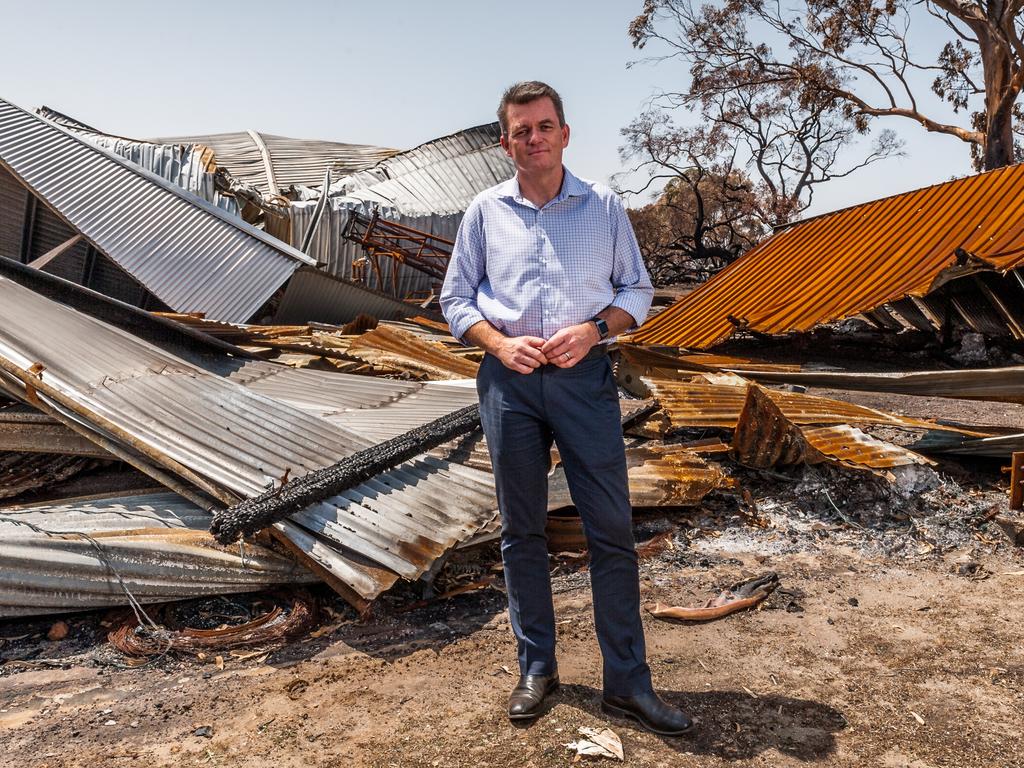Bushfires: How system failed our courageous volunteers
Volunteer firefighters who fought the historic bushfires were sent to firefronts with outdated equipment despite warnings.

Volunteer firefighters who fought this season’s historic bushfires were sent to firefronts with outdated trucks and personal protective equipment, at-times poor radio communications and substandard technological capabilities, despite multiple reviews recommending urgent upgrades.
Around the country — from NSW to Queensland, Victoria to South Australia — volunteer firefighters contended with trucks that lacked the latest emergency sprinkler systems and heat-resistant materials, or did not have roll bars and protection against falling tree branches.
The Weekend Australian can reveal that a funding plea from the NSW Rural Fire Service to upgrade thousands of dilapidated and outdated trucks has been sitting idle with the NSW government for months while volunteers have been battling the fires.
After the fire danger was finally declared under control this week, attention has shifted to a range of independent audits of equipment and responses across the country.
Already coming to light are a litany of shortfalls, with organisations running on a shoestring at times, often hampered by a lack of resources already in use by rival and paid firefighting services.
From tin-shed stations in rural hamlets to inland brigades in wealthy council districts, many volunteers made do with trucks not equipped for the extreme conditions. Some in NSW and South Australia lacked advanced emergency watering systems to keep tyres from melting and batteries from failing, according to numerous sources. Some trucks were deployed without heat-resistant material along brake lines, or foil curtains for windows, and other basic apparatus such as self-winding hoses.
A business case submitted to NSW Emergency Services Minister David Elliott last year outlined extensive deficiencies with the NSW RFS fleet of 3820 tankers, The Weekend Australian can reveal. Funding for the existing tankers had been due to expire last year; an official said this was the catalyst for the business case to be conducted.
The document took issue not with the number of trucks in the fleet, but with the quality of the vehicles, some of which were nearly 30 years old. The most outdated were being used in rural locations that bore the brunt of the fires.
Brian McDonough, president of the NSW Rural Fire Service Association, the representative body for 70,000 registered volunteers, said: “With current expenditure we can’t replace them quick enough. Some of the trucks are over 25 years old and therefore the protection and technology is not the same as the trucks that are less than four or five years old.”
Mr Elliott’s office confirmed a business case had been submitted “as part of the budget process for the next financial year and will be considered”.
Victorian firefighting authorities have identified similar shortfalls with their antiquated tanker fleet, considered by volunteers to be the oldest in the country. In South Australia, heat curtains and sprinkler systems are not standard in firefighting vehicles.
Inadequacies with the NSW RFS truck fleet, while significant, are a mere glimpse into the shortfalls that confronted those who fought the fires this season. Sub-par breathing apparatus, antiquated IT systems, an inability to locate trucks in the field, and a shortage of Blackhawk helicopters for shuttling firefighters to battlegrounds have been identified as areas in need of attention.
The RFS hands out P2 masks to all volunteers but these have been criticised for only keeping out particulate matter, not gas or smoke. Facial hair can also affect whether these masks remain sealed.
At Horsley Park RFS brigade, some firefighters paid for their own breathing apparatus due to their concerns with the efficacy of P2 masks. Others crowdsourced the money and were chided by management. “We are concerned that members may be establishing these (crowdfunding pages) without the appropriate authority of their Brigade and District Manager,” said an RFS note dated December 12, 2019, and signed by deputy commissioner Rob Rogers.
The NSW RFS responded in a statement that an imminent audit of safety equipment would address concerns with tankers, masks and other personal protective equipment. A parallel inquiry launched by Premier Gladys Berejiklian last month has begun and is expected to look at equipment failures and other aspects of the fires, including the shortage of volunteers.
Similar volunteer shortages were known to have been experienced in Victoria, where the total of 34,380 operational volunteers was said to be among the lowest seen on a per-capita basis. In NSW, trucks were left idle in some instances because they could not be staffed by the requisite number of volunteers.
As of last year, the RFS had 71,801 registered volunteers, according to its annual report, but figures obtained by The Weekend Australian revealed that only 20,199 of its members attended an incident that year.
One reason for this decline is attributed to country towns losing their populations to the cities, a fact highlighted in the 2018 review of the NSW Bega Valley fires, which destroyed 65 homes.
NSW Volunteer Fire Fighters Association president Mick Holton said: “They need people; they don’t have enough people. We had plenty of cases where there were more trucks than people.”
Such shortages led to volunteers working without rest. Vehicles crashed, temper flared, morale ran low at times. Hugh McDermott, a Labor MP and volunteer firefighter at Horsley Park RFS brigade, said: “They couldn’t get enough drivers because people were constantly under the pump. Everyone’s a volunteer but they have work commitments — people just couldn’t take every single day off for months.”
The RFS said in a statement it was not aware of such instances.
Another critical shortfall that is likely to become a focal point for independent investigators is the ongoing lack of automatic vehicle location technology, which would have allowed RFS commanders to pinpoint vehicles on a screen. Currently this is not possible, even though it was recommended by the Bega Valley fires review.








To join the conversation, please log in. Don't have an account? Register
Join the conversation, you are commenting as Logout